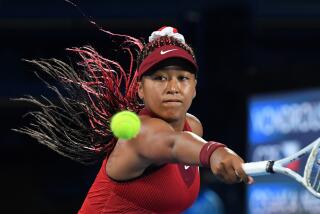King’s Impact Touched Sports and Society
- Share via
NEW YORK — Billie Jean King hasn’t always been around, although sometimes it must seem that way. She was there in 1961, her first U.S. Open, in thick eyeglasses with large, white frames and a tennis skirt sweeping around her knees, long before hemlines headed north. She was there in 1970 at the birth of women’s professional tennis, a women’s libber in sweats and sneakers. The ‘80s? King reached the stature of former champion, monument, pioneer.
“I’ve seen it all,” said King, who witnessed the era of wooden rackets and grass courts, the introduction of neon-colored balls, the soaring popularity of the women’s game. Why, when King first started out, the sport was rooted in turn-of-the-century tradition and still known as “lawn tennis.”
She was right there when tennis drew its biggest crowd ever. Before that, she led the caravan of female players barnstorming from one small event to another for pocket change. If you’ve ever seen an old black-and-white photograph of King back then, two things hit home. One, she looks like a librarian, not an athlete. And, two, her name on the caption is Billie Jean Moffitt.
So there it is. Billie Jean King has been around so long, she was there before she was Billie Jean King.
“Those were the days when no one bothered to talk to the women, except maybe the top one or two, now and then,” King said. “It was, like, ‘You want to interview me? Fine. You want to do it during the match? Okay.’ We would do anything to get attention for ourselves.”
King is 46 now, still crusading, although no woman in history has had a bigger impact on sports, maybe even on society. Without King, women might not be earning millions of dollars in prize money, matching the men. Tennis, ignited by King’s victory over Bobby Riggs on a network TV extravaganza, wouldn’t have boomed. And women athletes never would have been regarded as role models, a long lob from the frumpy “jock-ette” image King’s generation once endured.
In fact, women’s pro tennis is celebrating its 20th anniversary next month thanks to King. She hasn’t played on the tour in seven years, hasn’t won a major tournament in 15, but still she’s identified with the revolution more than anyone, a sort of Paula Revere, riding into the night -- arms waving, cape flying.
The woman in the faded snapshot, jabbing her finger to make a point when the women rebelled against the United States Tennis Association, that was King. The queen, carried into the Astrodome on an Egyptian litter for the 1973 epic match against Riggs -- that was King, too. Imagine, last year Steffi Graf earned $1.9 million, about as much money as King won in her entire career, but King, well, she has her immortality. She practically invented the women’s circuit.
“I didn’t do it to become famous,” King said. “There were many women involved in the formation of the women’s tour besides me, but they’ve just never gotten the credit because, maybe, I was out front. I didn’t mind being vocal. It suited me. All the girls would say, ‘Oh, Billie Jean, you know what to say, we don’t.’ They figured I was the loudmouth.”
By then, she was married to promoter Larry King, now her ex. But King also was wed to the feminist movement, this in the days when women routinely received half of what the men got for winning Wimbledon. Backed by philanthropist and former amateur Gladys Heldman and later by Joseph Cullman III, chairman of the Philip Morris Co., which was about to market the Virginia Slims cigarette for women, King pressed for more money, more events, more say, until in 1970 she and her band of rebels bucked the USTA to start their own tour. This was heady stuff.
As it turned out, the first shot was fired at the U.S. Open that year, back when it was played at ivy-coated Forest Hills. King learned that tennis legend Jack Kramer, promoter of the Pacific Southwest tournament, planned to award $12,500 to the men’s champion and only $1,500 to the women’s winner at his event a few weeks following the Open. Under the threat of suspension by the USTA, King and Heldman responded by organizing their own tournament Sept. 23-26 in Houston to compete directly with Kramer’s, which at the time was about as bold a development as hot pants.
At first, King was joined by only eight others, including Rosie Casals, Nancy Richey and Peaches Bartkowicz. While Margaret Court, Yvonne Goolagong and Chris Evert did not immediately join the new circuit (Evert being 16, and just out of juniors), the brand-new Virginia Slims tour, though it wheezed and coughed, ultimately survived. Betty Stove recalled in King’s 1988 book, “We Come A Long Way,” giving away tournament tickets from a booth at K-Mart.
“It was a very lonely time,” King said. “Tough, disappointing, exciting -- we had all those emotions. There were some women who had negative feelings about it all, who didn’t know where we were going. The other women, the ones who were with us, would talk about the criticism we were getting and I would tell them, ‘But those people don’t see what we’re seeing. You understand?’ I could see clearly where we were going to be 10 years down the road. I remember Lesley Hunt saying to me, “Billie Jean, we really don’t see those things.’ I tried to draw them a picture.”
This was it: a year-round women’s tour as organized and profitable as the men’s; better tournaments; increased public recognition; and women competing for millions of dollars, same as the men.
It all came to pass. Within three years, King helped fashion a truce between her group, which had grown to 60 women strong, and the USTA. In 1973, the women’s championship prize at the U.S. Open was $25,000, up from the $10,000 King had earned for winning the same event a year earlier. These days, the women’s Open title is worth $350,000. Same as the men.
It couldn’t have happened without King, and maybe it wouldn’t have happened without Riggs, either. Riggs, the bookish, balding 1939 Wimbledon champion, was 56 when he challenged the 30-year-old King to a $10,000, “winner-take-all” match, although the stakes soon would grow far beyond that. A hustler, Riggs played the role of male chauvinist pig -- boasting that even old men were superior tennis players to women pros and deserved to make more money -- hyping the gate and turning the meeting into a spectacular event the likes of which tennis never knew before.
On Sept. 20, 1973, King met Riggs in the Astrodome before a crowd of 30,472, the largest in the history of the sport, not to mention the estimated 50 million watching on prime-time TV. Even today, you think of King, you think of Riggs.
“I thought, if I lost, it wasn’t going to ruin my life,” King said. “But I knew it would hurt our circuit. We were in our third year. I knew I had to win. I knew that we had worked so hard and that if Billie Jean King didn’t win that everything we had worked so hard for, for 2 1/2 years, would go up in smoke in 2 1/2 hours.”
Never mind that the match, billed as “The Battle of the Sexes,” was just the kind of venture King despised. It pitted Men vs. Women, again, when all her life King had fought for cooperation, for boys getting along with girls, and there she was in Houston getting ready to play a man the same age as her own father, not for the original $10,000, but for the then-staggering sum of $100,000.
She won 6-4, 6-3, 6-3. “From an athletic stand-point,” King said, “it was a joke.”
All she’d proved was that she could beat this pudgy relic in horn-rimmed glasses, but in the process, people -- a lot of people -- discovered tennis. Now, ask Casals who did the most for women’s tennis and she doesn’t say “Billie Jean King,” she laughs and says, “Bobby Riggs.”
“It was great for tennis,” King said. “Virginia Slims got on CBS the next year. People liked tennis. So the Riggs match was a wonderful development for tennis. It was a showcase. Maybe people weren’t watching it for the tennis. They were watching ‘The Battle of the Sexes.’ But it was a happening. It was just what we needed.”
King, of course, would go on to her fourth Open championship the next year and her sixth Wimbledon title the year after that, but already her career was winding down. Although it seems hard to believe now, King’s No. 1 ranking for 1974 was her first and last, with Evert and Martina Navratilova already looming on the horizon.
Naturally, King would have led the rankings earlier in her career, but there weren’t any before 1973. See, King came even before the rankings.
And in all that time, precious few people have ever thought to express their gratitude for the road King paved, especially the younger generation. “Ah, you know kids today,” King said. “They don’t know me. They don’t care. Kids today, they think the world started five minutes ago.”
But several years back, King visited Wendy Overton, an old friend who played in the early ‘70s, in Florida. “I walked into her house, and she has a beautiful home,” King said. “And she said, ‘See this? I got this because of you. Thanks.’ I don’t think anyone else has ever thanked me, and I don’t expect it. If they did, you could knock me over with a feather, right?
“But when Wendy said that, hey, that was nice.”
More to Read
Go beyond the scoreboard
Get the latest on L.A.'s teams in the daily Sports Report newsletter.
You may occasionally receive promotional content from the Los Angeles Times.










